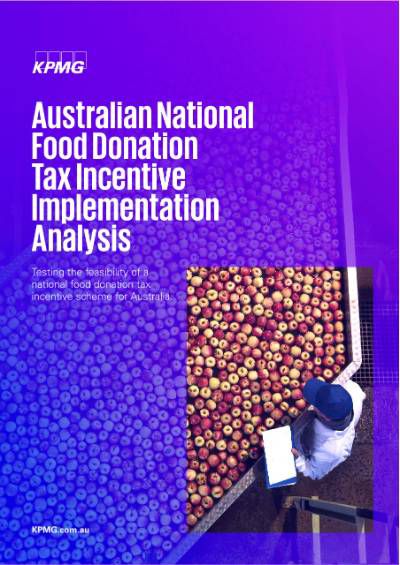In 2020 we delivered a report on boosting food relief through the Australian tax system. At this time, the concept of a National Food Donation Tax Incentive (NFDTI), previously referred to as the National Food Waste Donation Tax Incentive, had gained significant support amongst the food relief sector, government stakeholders, consumer goods and agribusiness supply chain participants, and retailers.
Since then, we have collaborated with Foodbank Australia to design, define and articulate how an NFDTI could work – helping meet Australia’s ambition of halving food waste by 2030 while addressing food insecurity.
We tested the NFDTI concept with different organisations along the food supply chain, to verify whether it could create positive change for the food relief sector and in turn, support the Australian environment, population, and economy.
Food waste facts
While we may be considered ‘the lucky country’, it’s disheartening to know that over one million Australians rely on food relief support every month. This has worsened since 2019 due to the pandemic, the rising cost of living and global supply chain issues. We’re now in a situation where food relief organisations are feeling overwhelmed and in need of a better solution.

3 times
Australia produces enough food each year to feed the population three times over.1

7.6 million tonnes
Australia generates 7.6 million tonnes of food waste each year.2

1.2 million
An estimated 1 in 6 adults and 1.2 million children have gone hungry in Australia every year. 3

$36.6 billion
70 percent of food waste is edible4, estimated to cost the economy $36.6 billion per year.5
The cost of living continues to rise and impact a growing number of households. Meanwhile, the end-to-end supply chain needs urgent reform to help businesses actively redirect edible food from going to waste. The NFDTI aims to increase the appetite of businesses to make an informed decision about allocating good quality edible food to the food relief sector, that might otherwise be written off.
The proposed tax incentive
The current measures to divert edible food waste from landfill to those in need comes at a cost many businesses can’t absorb, or don’t have the capacity to action.
We worked with the Fight Food Waste CRC and Foodbank Australia to propose how the NFDTI framework could be brought to life.
Key elements of the framework:
The proposed NFDTI combines examples of successful global food donation tax policies with Australia’s current tax system.
It aims to incentivise businesses to donate edible food or related services to food relief organisations – in return, they’ll receive a tax rebate or offset.
Overall, the proposed incentive could bring Australian food supply chain participants together, to work towards the common goal of halving food waste by 2030 and redirecting it to those in need.
Recommendations
Feedback showed the tax reductions offered by the NFDTI were attractive to stakeholders, but first and foremost it was acknowledged that the priority is to work together to reduce food waste at the source, and support food insecure Australians.
To bring the proposed NFDTI to life, the report made the following recommendations.
Realisation
- Work with the Treasury Department and Australian Taxation Office (ATO) to agree on scope, parameters, pocesses and legislative requirements.
- Keep to the original scope: Food fit for human consumption, pet food and essential grocery items, donated to registered food relief charities.
- Incentive to be claimed as part of the annual tax return process.
Implementation
- To be implemented in consultation with the food relief sector and relevant stakeholders.
- Consider developing a self-assessment calculator to make sure the incentive is accessible to all businesses in the supply chain.
- Food relief charities and businesses may need to consider expanding their processes and upgrading their systems to accommodate the changes.
Promotion
- Select stakeholders to act as champions of the NFDTI – promoting it to their supply chain networks to support capacity building and raise awareness.
- Develop communication campaigns to focus on the differentiating factors of the NFDTI, including the tax reductions, and how they’re applied across the supply chain.



